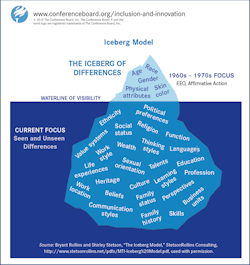Our industry is facing a competitive war for skilled talent. Employers who aren’t contending with workers signing out of the workforce in what some are calling “The Great Resignation,” are stuck facing dynamic market shifts and increasing difficulty attracting talent.
Women make up over half of the U.S. population, but only 11% of the construction industry. For skilled frontline workers, that percentage is even less—just 3.4%. While it’s projected that 40% of the available workforce is set to retire in the next 10 years, who does that leave to fill the gap?
Boston University MBA graduates Teilachanell Angel and Misty Farrell have spent months devising a plausible answer to that question. Their solution: hire more women.
But that answer requires more nuance than it sounds. To integrate more women into the construction workforce—to really tear down barriers that have built up over years of established societal narratives—it’s going to take multiple strategies and implementations.
Angel and Farrell, co-authors of Women Breaking Barriers: A Guide to Recruiting, Training and Retaining Women in the Residential Construction Trades, partnered with Building Talent Foundation (BTF). This non-profit organization was founded to advance the education, training, and career progression of young people and people from underrepresented groups. The foundation, led by CEO Branka Minic—who played an invaluable role in the development of the study—coordinates public-private partnerships to advance the sustainable employment goals of stakeholders and communities.
Four Implementation Strategies
Working in tandem with one-another, the co-authors’ offer a four-pronged proactive and intentional strategy for hiring and retaining women in construction.
A holistic approach is essential in order for the strategies to work, according to Angel. These are a mutually-reinforcing set of recommendations, and should be treated as a whole.
1. Targeted Diversity Recruiting
The first step is recruiting. Angel and Farrell suggest that employers signal that diverse workers are welcome, and that their recruiting and training materials reflect inclusive imagery and language.
The co-authors emphasize the importance of meeting women where they are—physical and online spaces that women frequent. One approach is to also partner with local community-based organizations that serve women, according to the paper.
Angel and Farrell spotlight many women-oriented pre-apprentice training providers in their study: Oregon Tradeswomen, Women Building Futures, WINTER, and HHW Ohio, for example.
These training programs build a pipeline for talent and building relationships.
The construction industry's unfavorable perception presents an obstacle to recruiting new talent, but the reasons behind it are varied. Young adults perceive the work as difficult and physically demanding and are unaware of its earning potential. Women and underrepresented minorities that have been historically excluded perceive the industry as unwelcoming. The industry's present-day lack of diversity reinforces this perception, and an overreliance on personal networks for recruiting entrenches it. Lastly, a high incidence of sexual harassment and discrimination further mar the industry's image driving attrition.
— Women Breaking Barriers: A Guide to Recruiting, Training and Retaining Women in the Residential Construction Trades
2. Providing Wraparound Supports
One of the most difficult challenges facing workers is a lack of supportive infrastructure. Wraparound supports allow learners and workers to show up for opportunities and sustain success. Such supports can help overcome the challenge of retaining women in training and employment.
These support systems, such as childcare infrastructure for women, transportation, mental health counseling, and other challenges that workers face, have a direct correlation to the success of these programs.
Research has found that by providing support systems that actively address barriers to women, equitable access to well paying careers can be achieved. Angel and Farrell found that participants in sectoral programs not only earned more, but were more likely to work, more likely to obtain higher wages, more likely to work in jobs that offered benefits, and had earnings that outpaced those of the control groups.
3. Creating Inclusive & Dignifying Work Cultures
Currently, the biggest barriers women in the industry face are gender narratives, societal beliefs that stereotype women’s roles and capabilities, precipitate harmful biases, discrimination, harassment, and sexual harassment, according to the co-authors.
“These problems are exacerbated in the construction industry where women are often the ‘only one’ on the jobsite,” says Angel.
Given the industry culture, how do we retain women as employees?
Organizations and employers can start by shifting to a Total Safety culture that embraces psychological safety and trauma-informed management. According to the report, understanding the effects of trauma on individuals, and understanding how that connects to their work life, is essential in safety and retention.
Besides this, organizations can create a culture of allyship. This focuses on building inclusive environments for workers, and encourages them to speak out against bad practices. Angel and Farrell also recommend implementing allyship and behavior-focused training like Bystander Intervention and Manager Training
Everyone in the construction industry has a role to play. Every tradeswoman and tradesman, workforce development professional, business, union member, policy maker, and funders can take meaningful action across the system and within their organizations to create impact. Because ultimately organizational culture is not a policy, training, or statement. Culture is what you do every day.
— Women Breaking Barriers: A Guide to Recruiting, Training and Retaining Women in the Residential Construction Trades
4. Building Cross-Sectoral Partnerships
Because no one can do it alone, the last step is to partner with training organizations, social services, and community-based organizations that serve women in need.
According to the report, employers should build and mobilize relationships through public-private collaboration of system leaders and stakeholders to align policies, practices, and resources towards a shared vision.
Essentially, leverage meaningful partnerships in which you share a common agenda, shared measurement systems, mutually reinforcing activities, continuous communication, and backbone support organizations.
Co-authors Angel and Farrell nod to Building Talent Foundation as being one such organization, which convenes and mobilizes stakeholders across the sector to coordinate workforce solutions. BTF has partnered with some of the largest names in construction to overcome skilled talent shortages.
In the paper, the co-authors spotlight several workplace culture organizations that can assist with initial assessment, training, and measurement: RiseUp by ANEW, GreenDot by Alteristic, Empowerment Institute byTwin Cities Rise, and Mindwise Innovations, to name a few.
Breaking Barriers & Biases
In order to increase women’s participation in the construction industry, we need to adapt. Co-authors Angel and Farrell suggest that we all grow up with certain narratives—ones that influence our adult experiences and biases. Most women don’t even consider going into construction because of this.
They emphasize the importance of education and a shift in perspective to be able to change the narrative.
“We all have a fundamental need for respect, for dignity,” says Angel. “Our essential workers don’t have the structural supports they need to protect themselves when they go out into the workplace.”
While this article has only scratched the surface of the co-authors’ research, the full paper is readily available to download.
To read the 48-page report, which includes testimonials from women in the industry and a Small Contractor Quick-Start Guide to New Talent, click DOWNLOAD REPORT below.

